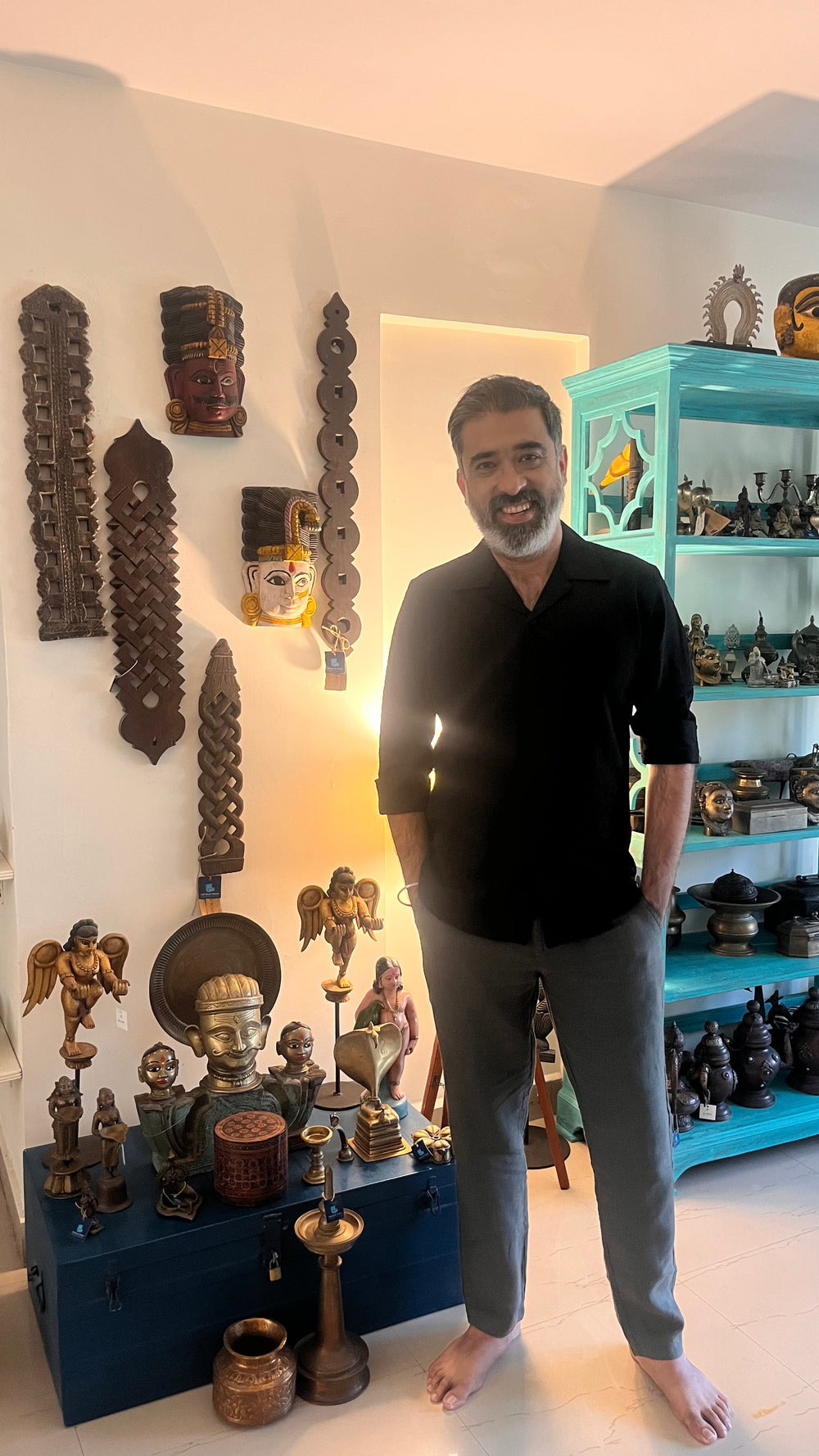The Allure of Vintage Indian Cookware – Materials Used and Health Benefits
Just like in traditional delicacies, there is tremendous diversity found even in the tools used to prepare them. Read to find out more!

India is renowned for its glorious diversities. The billion-strong nation is an enviable amalgamation of vastly different cultures, traditions, and languages peculiar to each region and is uniquely Indian. But all these evident disparities are seamlessly integrated by an element that stems from a fundamental need – food.
The hissing oil, the spluttering seeds, and the fragrance of pounded spices permeating homes with distinct aromas bear the resident's traditional cuisine's hallmark. Undeniably, every Indian home's heart is its kitchen, and many enjoy a special bond with the traditional utensils that have held their place in the family kitchen for decades.
The specific flavor, proportion of ingredients, and preparation techniques are important and have been tried and perfected over generations, but equally important are the vintage Indian kitchen utensils and the material of the cookware used to lend an authentic taste that tantalizes the taste buds.
Materials used in Vintage Indian Cookware
The cooking utensil material impacts the uniform distribution of heat, the even cooking of food, preservation of nutrients, the signature taste of the dish, and the duration of cooking. The materials used in vintage Indian cookware were chosen to enhance the health benefits of the food cooked in them and also be chemically non-reactive and non-toxic.
Here are a few materials that were used in crafting traditional Indian cooking utensils.
Stoneware utensils
The thickness and density of stone make it easy for stoneware to retain heat for a longer time and distribute it evenly. It is probably the oldest form of cookware used by humans. Traditional stone bowls were used to heat water and prepare stews. With no chemicals and an abundance of natural minerals in them, vintage stoneware replicas are gaining popularity now. ‘Kalchatti’ made of Maavu Kal (aka soft stone) is handcrafted and has carved a niche of its own among the health-conscious.

Earthen Cookware
Hand-made, coarse pottery of various shapes and bright colors can be traced back to the Mesolithic age. Rustic clay cookware has been used across India for centuries. Clay pots are as eco-friendly as you can get and are widely used to store and cool water, cook, and serve tea (in ‘mudkhas’ or cups), especially in rural India. They are affordable and can be easily disposed of if they break. The best feature is that they leave no toxins behind.
Brass utensils
Brass cookware has been used in Indian kitchens for centuries, not only for the unique taste it lends to food but also for its health benefits. Pure brass is a combination of copper and zinc, both of which are minerals necessary for good health. Water stored in brass vessels is said to improve immunity. Vintage brass utensils were crafted to be functional but with a keen aesthetic eye so that they could adorn and beautify all living spaces of the house.



Copper vessels
Many vintage pots and pans were made of copper. Copper is a good conductor and a 'responsive' metal that responds quickly to temperature changes, giving the cook greater control over the heat applied. Traditional copper vessels were made of various gauges to cook food evenly and to maintain its texture.
Copper is a trace mineral essential for maintaining nerve cells and having a robust immune system. Copper is considered the best metal to cook rice and store water. Studies have proven that copper boosts collagen and is beneficial to your skin.

Iron cookware
Iron pans and skillets have truly stood the test of time. Iron is a good conductor and helps even the heating and cooking of food. They are also durable and versatile. A study featured in the Journal of American Dietetic Association observes that cooking in iron utensils increases the iron content in the food cooked, especially in acidic food such as tomato puree. Iron is responsible for transporting oxygen in our body.
Wooden cookware
Vintage wooden storage utensils and wooden appliances were among the most commonly used in the kitchens of ancient India. Surprisingly enough, the very same is used even today, albeit with slight variations and many varieties.

Vintage Cookware for Different Styles of Cooking
The cooking style to be adopted played a decisive role in choosing the vintage cookware material.
-
Tempering or Tadka is done at the end of cooking and involves frying spices in hot oil and adding it to the food. This flavor-enhancing process was done using a long-stemmed and deep Tadka ladle of iron.
-
Stewing involves spluttering spices in hot oil and then cooking the vegetables (or meat) in water over a low flame until a flavorful gravy is got. Deep casserole pans made of iron were preferred.
-
Tandoori is the traditional baking of India. Tandoors were made of clay and had heat from burning wood and charcoal. The smoke not only cooks the food but also leaves an inimitable smoky flavor.
-
Deep frying or Talna is, as the name suggests, deep-frying food in hot oil to obtain a crispy texture. Deep cast iron fry pans of various sizes were used.
-
Sauteing or Bhuna is done by cooking the food with a minimal quantity of oil and water. This is a quick process that required a broad, flared iron pot that is usually deep. The wok used is called a kadhai.
-
Steaming is a healthy cooking procedure that has been used across India and involves cooking the food using steam without any oil. Brass steaming vessels – such as the Idli steamer below – were used commonly.
Conclusion
There are a set of pros and cons associated with each material used to make kitchen utensils. The utensil material depended on various factors such as the cooking method used, the amount of food cooked, and the best way of preserving the nutritional content of the food. Vintage cookware was designed tastefully to combine functionality with alluring aesthetics.
At The Blue Trunk, our Vintage Kitchen collection is more than just an assortment of traditional cookware; it's a heartfelt tribute to the culinary legacies that have shaped Indian households for generations. Each piece is a carefully curated artifact, echoing the rhythms of ancestral kitchens where meals were crafted with love, patience, and time-honored techniques.
Imagine the gentle clatter of a brass spice box being opened, releasing the rich aromas of cumin, coriander, and cardamom. Envision the sturdy presence of a Vintage Brass Grain Measure, once a staple in Indian kitchens for measuring grains, now a charming addition to your home decor. These aren't just utensils; they're vessels of memories, reminiscent of the warm, bustling kitchens of our grandmothers.
Our collection features treasures like the Vintage Brass Betel Box, a nod to the age-old tradition of offering paan to guests, symbolizing hospitality and warmth. The Vintage Wooden Stringhopper Press, sourced from Tamil Nadu, harks back to a time when string hoppers were made by hand, adding a touch of vintage charm to your kitchen decor. Each item, from the Vintage Brass Thooku, a traditional storage canister, to the Vintage Bronze Jug, used for serving milk or buttermilk, tells a story of regional craftsmanship and culinary artistry.
By bringing these pieces into your home, you're not just enhancing your kitchen's aesthetic; you're embracing a lifestyle that values sustainability, authenticity, and a deep connection to our roots. Let your kitchen resonate with the soulful echoes of the past, where every meal was a labor of love and every utensil had a story to tell.
Explore our Vintage Kitchen collection and let your culinary space be a canvas where tradition meets timeless elegance.


